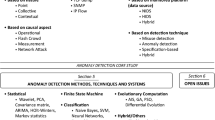Abstract
In this paper, we propose a method to detect network intrusions using anomaly detection technique based on probabilistic analysis. Victim’s computers under attack show various symptoms such as degradation of TCP throughput, increase in CPU usage, increased round trip time, frequent disconnection to the Web sites, etc. These symptoms can be used as components to construct the k-dimensional feature space of multivariate normal distribution, in which case an anomaly detection method can be applied for the detection of the attack on the distribution. These features are generally highly correlated. Thus we choose only a few of these features for the anomaly detection in multivariate normal distribution. We use Mahalanobis distance to detect the anomalies for each data, normal, and abnormal. Anomalies are identified when their square root of Mahalanobis distance exceeds certain threshold. A detailed description of the threshold setting and the various experiments are discussed in simulation results.





Similar content being viewed by others
Explore related subjects
Discover the latest articles, news and stories from top researchers in related subjects.References
Bayarjargal D, Cho G (2014) Detecting an anomalous traffic attack area based on entropy distribution and mahalanobis distance. Int J Secur Appl 8:87–94
Bhat A, Patra S, Jena D (2013) Machine learning approach for intrusion detection on cloud virtual machines. Int J Appl Innov Eng Manag 2:56–66
Chen T, Zhang X, Jin S, Kim O (2014) Efficient classification using parallel and scalable compressed model and its application on intrusion detection. Expert Syst Appl 41:5972–5983
Jingle IDJ, Rajsingh EB (2014) ColShield: an effective and collaborative protection shield for the detection and prevention of collaborative flooding of DDoS attacks in wireless mesh networks. Hum Centric Comput Inf Sci 8:1–19
Johnson RA, Wichern DW (eds) (2007) Applied multivariate statistical analysis, 2nd edn. Pearson Prentice Hall, Upper Saddle River
Joo J, Lee J, Park J (2015) Security considerations for a connected car. J Converg 6:1–9
Keegan N, Ji S, Chaudhary A, Concolato C, Yu B, Jeong DH (2016) A survey of cloud-based network intrusion detection analysis. Hum Centric Comput Inf Sci 6:1–16
Kolahi SS, Treseangrat K, Sassafpour B (2015) Analysis of UDP DDoS flood cyber attack and defense mechanisms on web server with Linux Ubuntu 13. In: 2015 international conference on communications, signal processing, and their applications (ICCSPA), vol 17–19
Lecture notes.http://www.ece.vt.edu/people/profile/mili
Lecture notes.https://www.coursera.org/learn/machine-learning
Lu K, Wu D, Fan J, Todorovic S, Nucci A (2007) Robust and efficient detection of DDoS attacks for large-scale internet. Comput Netw 51:5036–5056
Scarfone K, Mell P (2007) Guide to intrusion detection and prevention systems (IDPS). NIST special publication 800–94, Gaithersburg, MD, USA
Shyu M-L, Chen S-C, Sarinnapakorn K, Chang L (2003) A novel anomaly detection scheme based on principal component classifier. In: Proceedings of the IEEE foundations and new directions of data mining workshop, Melbourne, FL, USA, pp 172–179
Singh R, Singh P, Duhan M (2014) An effective implementation of security based algorithmic approach in mobile adhoc networks. Hum Centric Comput Inf Sci 4:1–14
Singh K, Guntuku SC, Thakur A, Hota C (2014) Big data analytics framework for peer-to-peer botnet detection using random forests. Inf Sci 278:488–497
Staniford S, Hoagland JA, McAlerney JM (2002) Practical automated detection of stealthy portscans. J Comput Secur 10:105–136
Stein G, Chen B, Wu A, Hua KA (2005) Decision tree classifier for network intrusion detection with GA-based feature selection. In: Proceedings of the 43rd annual Southeast regional conference, vol 2, pp 136–141
Tan L, Sherwood T (2005) A high throughput string matching architecture for intrusion detection and prevention. In: 32nd international symposium on computer architecture, pp 112–122
Tseng F-H, Chou L-D, Chao H-C (2011) A survey of black hole attacks in wireless mobile ad hoc networks. Hum Centric Comput Inf Sci 1:1–16
Tuck N, Sherwood T, Calder B, Varghese G (2004) Deterministic memory-efficient string matching algorithms for intrusion detection. In: IEEE Infocom, pp 333–340
Valdes A, Skinner K (2000) Adaptive model-based monitoring for cyber attack detection. In: Recent advances in intrusion detection, Toulouse, France, pp 80–92
Warren R, Smith R, Cybenko A (2011) Use of Mahalanobis distance for detecting outliers and outlier clusters in markedly non-normal data: a vehicular traffic example. Interim Report (United States Air Force), pp. 9–11
Weon I, Song D, Ko S, Lee C (2005) A multiple instance learning problem approach model to anomaly network intrusion detection. Int J Inf Process Syst 1:14–21
Ye N, Emran SM, Chen Q, Vilbert S (2002) Multivariate statistical analysis of audit trails for host-based intrusion detection. IEEE Trans Comput 51:810–820
Yeung D-Y, Ding Y (2003) Host-based intrusion detection using dynamic and static behavioral models. Pattern Recognit 36:229–243
Zhao W, Ma H, He Q (2009) Parallel k-means clustering based on mapreduce, (Cloud Computing 2009). Lect Notes Comput Sci 5931:674–679
Acknowledgements
This research was supported by the Ministry of Science, ICT and Future Planning (MSIP), Korea, under the Information Technology Research Center (ITRC) support program (IITP-2016-H8601-16-1009) supervised by the Institute for Information and communications Technology Promotion (IITP)
Author information
Authors and Affiliations
Corresponding author
Ethics declarations
Conflict of interest
Authors JinSoo Park, Dong Hag Choi, You-Boo Jeon, Yunyoung Nam, Min Hong and Doo-Soon Park declare that he/she has no conflict of interest.
Ethical approval
This article does not contain any studies with human participants or animals performed by any of the authors.
Additional information
Communicated by G. Yi.
Rights and permissions
About this article
Cite this article
Park, J., Choi, D.H., Jeon, YB. et al. Network anomaly detection based on probabilistic analysis. Soft Comput 22, 6621–6627 (2018). https://doi.org/10.1007/s00500-017-2679-3
Published:
Issue Date:
DOI: https://doi.org/10.1007/s00500-017-2679-3




